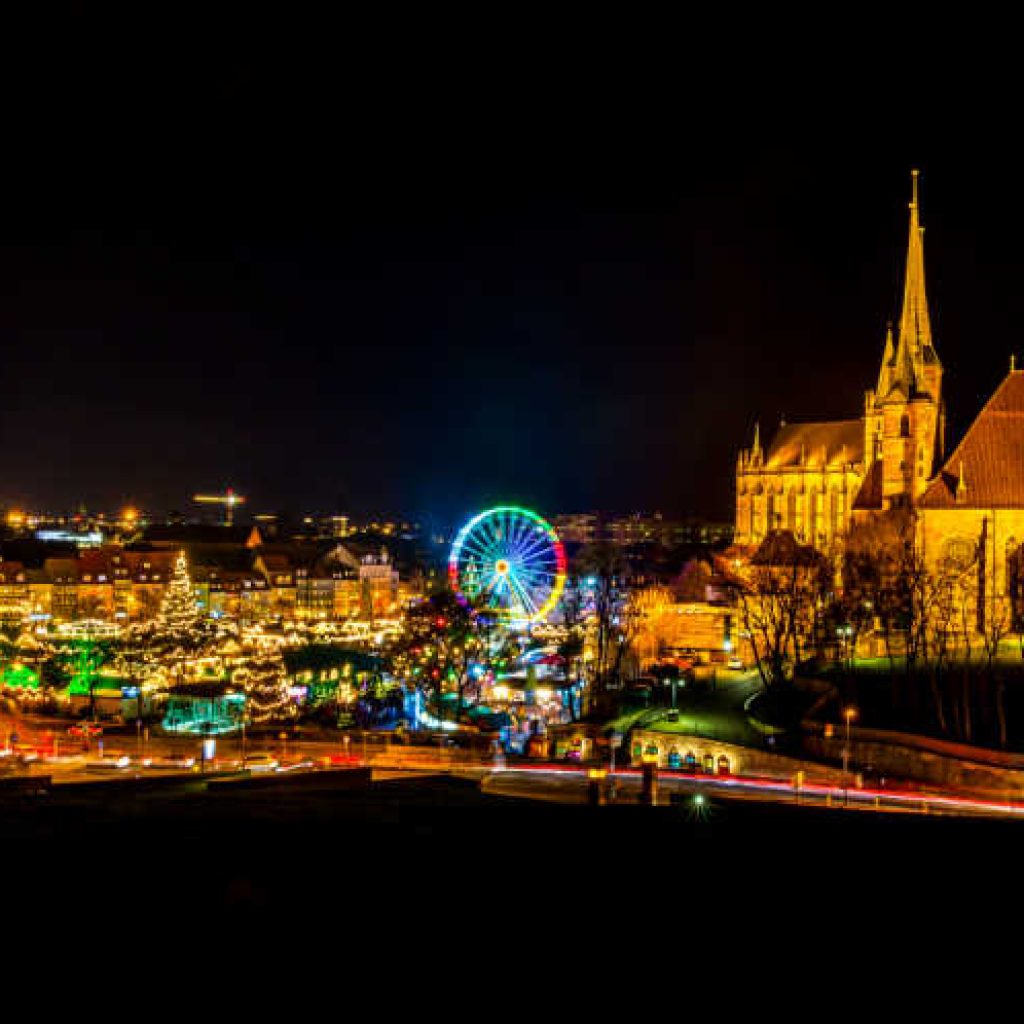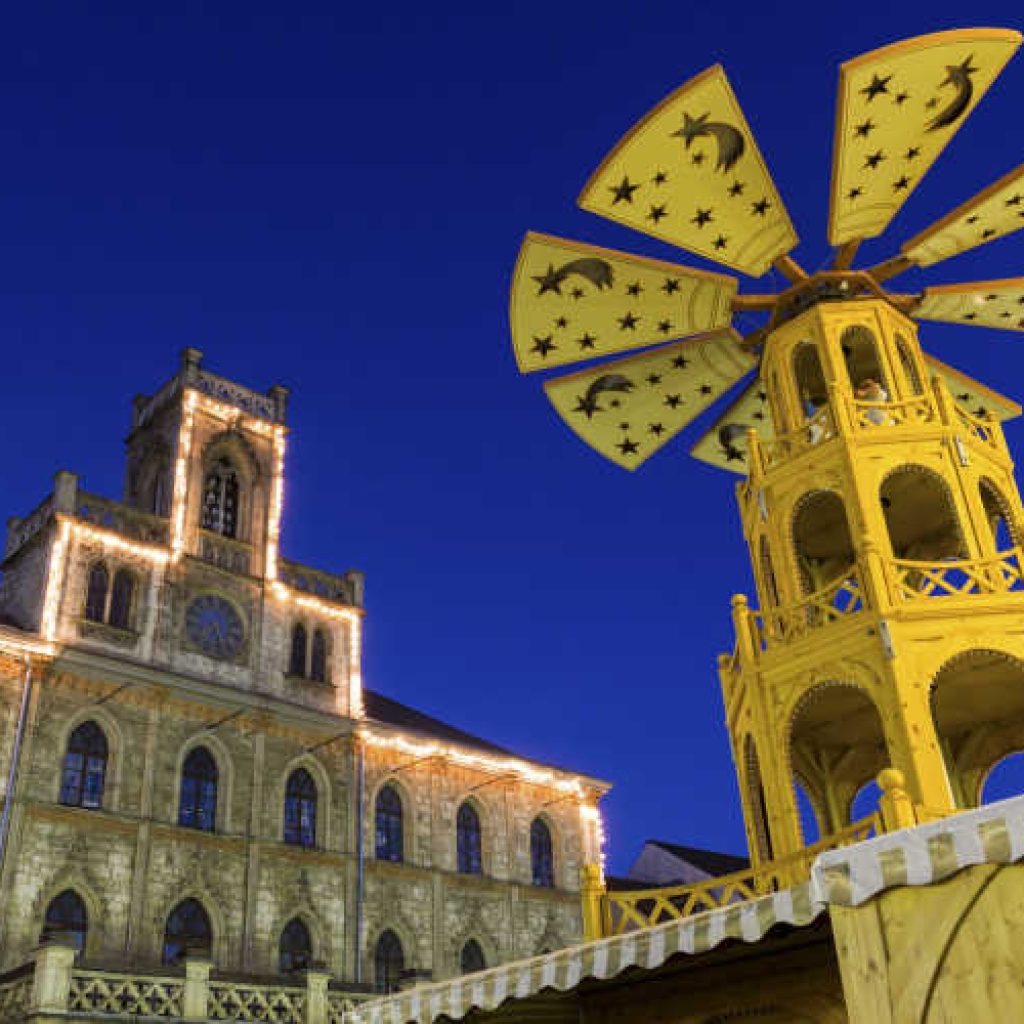Twinkling lights, wooden stalls filled with local wares, glockenspiels and the delicious warmth of Glühwein—the season’s traditional spiced mulled wine combine to create the magical experience of Germany’s Christmas markets. As the place where many Christmas traditions began, the State of Thuringia in eastern Germany delivers a truly special experience steeped in longstanding traditions. From a medieval bridge lined with shops and galleries to a village where the first glass Christmas ornament emerged, you’ll remember this experience for years to come.
The Spellbinding Market of Erfurt
Martin Luther, the great Reformer, once declared Erfurt “the perfect place for a city.” The capital of Thuringia dates back more than 1,270 years. It’s truly a charming city in any season with its beautifully preserved old quarter, half-timbered buildings and the Merchants Bridge—a medieval bridge lined with shops and galleries displaying the work of local artisans. But when the holiday season arrives, Erfurt transforms into a spellbinding display of sights and sounds.
In the heart of the city, Domplatz boasts one of Germany’s largest Christmas markets. Set against the spectacular backdrop of the majestic St. Mary’s Cathedral and the Church of St. Severus, the welcoming aromas of spiced mulled wine, gingerbread and sausage fill the air as you wander through the town’s main square. Over 200 wooden huts display everything from candles to hand-crafted toys to Christmas tree decorations. There’s also plenty to satisfy your appetite including regional favorites such as Thuringian bratwurst and Erfurt schittchen, a stollen so good it’s been registered as a trademark.

The History and Charm of Weimar
A UNESCO World Heritage site with 14 protected buildings, Weimar was home to many notable figures in history. Johann Wolfgang Goethe and Friedrich Schiller lived and wrote here. Johann Sebastian Bach played the organ, Franz Liszt was a music director and Carl Maria von Weber composed. It’s the birthplace of Bauhaus—a revolution in design. And, in 1815, Weimar became the site of the first public Christmas tree erected in Germany.
Bookseller Johann Wilhelm Hoffmann erected the first Christmas tree outside of his shop. His desire for the poor and orphaned children of Weimar to have a Christmas tree sparked a worldwide tradition. To commemorate his gesture, every year the elaborately decorated tree is erected on the market square to the accompaniment of Christmas carols performed by local choirs.
A highlight of the Weimar Christmas market is the Gothic Weimar Town Hall. During the season, the 24 windows of the building are converted into a life-size Advent Calendar. Each day a window is opened by local children to discover a theme of the day at the market. You’ll also find a uniquely Weimar display on the wooden huts of the market—the onion plait. A nod to Weimar’s favorite vegetable celebrated each October at Zwiebelmarkt, the Onion Market. The festival began in 1635 as a “market for onions and beasts” and continues today. Attracting upwards of 350,000 visitors over three days, the Onion Market is the largest festival in Thuringia.

A Castle for Christmas in Eisenach
Perched high on a mountaintop, the Wartburg Castle silently watches over the city of Eisenach below. Dating back as far as the Middle Ages, the castle showcases a blend of Gothic, Romanesque and Renaissance architecture. Centuries of history unfold within its ancient walls decorated with mosaics, frescoes, and other expressions of German Romanticism. The castle sheltered Martin Luther while he translated the New Testament into German. No visit to Eisenach is complete without a trip up to the castle. Castle courtyards fill with medieval musicians, performers and puppeteers during the Christmas market as Advent concerts in the ceremonial hall evoke the holiday spirit.
Experience the Craftsmanship of the Thuringian Forest
While the city markets delight, a visit to the Thuringian Forest is essential to discover the place where so many Christmas traditions were born. Producing traditional wooden toys, dolls and stuffed animals for centuries, Sonneberg earned the title of “Santa’s other workshop.” The town still produces high-quality toys and also houses the German Toy Museum.
Tucked into the Thüringer Schiefergebirge Mountains, surrounded by forests, you’ll find the small village of Lauscha. It was here that the first glass Christmas ornaments were created in the 16th century. Generations later, the original family still produces ornaments for distribution around the world. I watched in amazement as the glassblowers transformed unlikely raw materials, including sand and limestone, into delicate masterpieces—and then I shopped. How could I resist so many beautiful things in one place?

